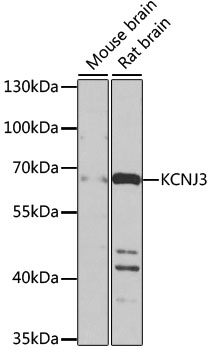Signal Transduction Antibodies 3
Anti-KCNJ3 Antibody (CAB9824)
- SKU:
- CAB9824
- Product Type:
- Antibody
- Applications:
- WB
- Applications:
- IHC
- Reactivity:
- Human
- Reactivity:
- Mouse
- Reactivity:
- Rat
- Host Species:
- Rabbit
- Isotype:
- IgG
- Research Area:
- Signal Transduction
Description
| Antibody Name: | Anti-KCNJ3 Antibody |
| Antibody SKU: | CAB9824 |
| Antibody Size: | 20uL, 50uL, 100uL |
| Application: | WB IHC |
| Reactivity: | Human, Mouse, Rat |
| Host Species: | Rabbit |
| Immunogen: | A synthetic peptide corresponding to a sequence within amino acids 50-150 of human KCNJ3 (NP_002230.1). |
| Application: | WB IHC |
| Recommended Dilution: | WB 1:500 - 1:2000 IHC 1:50 - 1:200 |
| Reactivity: | Human, Mouse, Rat |
| Positive Samples: | Mouse brain, Rat brain |
| Immunogen: | A synthetic peptide corresponding to a sequence within amino acids 50-150 of human KCNJ3 (NP_002230.1). |
| Purification Method: | Affinity purification |
| Storage Buffer: | Store at -20'C. Avoid freeze / thaw cycles. Buffer: PBS with 0.02% sodium azide, 50% glycerol, pH7.3. |
| Isotype: | IgG |
| Sequence: | NGRC NVQH GNLG SETS RYLS DLFT TLVD LKWR WNLF IFIL TYTV AWLF MASM WWVI AYTR GDLN KAHV GNYT PCVA NVYN FPSA FLFF IETE ATIG YGYR Y |
| Gene ID: | 3760 |
| Uniprot: | P48549 |
| Cellular Location: | Membrane, Multi-pass membrane protein |
| Calculated MW: | 26kDa/56kDa |
| Observed MW: | 60kDa |
| Synonyms: | KCNJ3, GIRK1, KGA, KIR3.1 |
| Background: | Potassium channels are present in most mammalian cells, where they participate in a wide range of physiologic responses. The protein encoded by this gene is an integral membrane protein and inward-rectifier type potassium channel. The encoded protein, which has a greater tendency to allow potassium to flow into a cell rather than out of a cell, is controlled by G-proteins and plays an important role in regulating heartbeat. It associates with three other G-protein-activated potassium channels to form a heteromultimeric pore-forming complex that also couples to neurotransmitter receptors in the brain and whereby channel activation can inhibit action potential firing by hyperpolarizing the plasma membrane. These multimeric G-protein-gated inwardly-rectifying potassium (GIRK) channels may play a role in the pathophysiology of epilepsy, addiction, Down's syndrome, ataxia, and Parkinson's disease. Alternative splicing results in multiple transcript variants encoding distinct proteins. |
| UniProt Protein Function: | GIRK1: This potassium channel is controlled by G proteins. Inward rectifier potassium channels are characterized by a greater tendency to allow potassium to flow into the cell rather than out of it. Their voltage dependence is regulated by the concentration of extracellular potassium; as external potassium is raised, the voltage range of the channel opening shifts to more positive voltages. The inward rectification is mainly due to the blockage of outward current by internal magnesium. This receptor plays a crucial role in regulating the heartbeat. Belongs to the inward rectifier-type potassium channel (TC 1.A.2.1) family. KCNJ3 subfamily. |
| UniProt Protein Details: | Protein type:Membrane protein, integral; Membrane protein, multi-pass; Channel, potassium Chromosomal Location of Human Ortholog: 2q24.1 Cellular Component: external side of plasma membrane; plasma membrane; T-tubule; voltage-gated potassium channel complex Molecular Function:G-protein activated inward rectifier potassium channel activity; inward rectifier potassium channel activity; protein binding Biological Process: potassium ion import; potassium ion transport; response to electrical stimulus; synaptic transmission |
| NCBI Summary: | Potassium channels are present in most mammalian cells, where they participate in a wide range of physiologic responses. The protein encoded by this gene is an integral membrane protein and inward-rectifier type potassium channel. The encoded protein, which has a greater tendency to allow potassium to flow into a cell rather than out of a cell, is controlled by G-proteins and plays an important role in regulating heartbeat. It associates with three other G-protein-activated potassium channels to form a heteromultimeric pore-forming complex that also couples to neurotransmitter receptors in the brain and whereby channel activation can inhibit action potential firing by hyperpolarizing the plasma membrane. These multimeric G-protein-gated inwardly-rectifying potassium (GIRK) channels may play a role in the pathophysiology of epilepsy, addiction, Down's syndrome, ataxia, and Parkinson's disease. Alternative splicing results in multiple transcript variants encoding distinct proteins. [provided by RefSeq, May 2012] |
| UniProt Code: | P48549 |
| NCBI GenInfo Identifier: | 1352482 |
| NCBI Gene ID: | 3760 |
| NCBI Accession: | P48549.1 |
| UniProt Secondary Accession: | P48549,Q8TBI0, B4DEW7, |
| UniProt Related Accession: | P48549 |
| Molecular Weight: | 26,829 Da |
| NCBI Full Name: | G protein-activated inward rectifier potassium channel 1 |
| NCBI Synonym Full Names: | potassium voltage-gated channel subfamily J member 3 |
| NCBI Official Symbol: | KCNJ3 |
| NCBI Official Synonym Symbols: | KGA; GIRK1; KIR3.1 |
| NCBI Protein Information: | G protein-activated inward rectifier potassium channel 1 |
| UniProt Protein Name: | G protein-activated inward rectifier potassium channel 1 |
| UniProt Synonym Protein Names: | Inward rectifier K(+) channel Kir3.1; Potassium channel, inwardly rectifying subfamily J member 3 |
| Protein Family: | G protein-activated inward rectifier potassium channel |
| UniProt Gene Name: | KCNJ3 |
| UniProt Entry Name: | KCNJ3_HUMAN |
View AllClose







